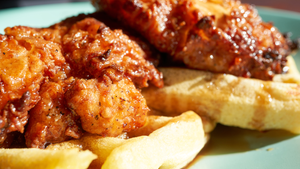Eye Care: a Case for Better Merchandising
With eye care sales showing promise, food retailers need to promote and cross-merchandise the category more often to win sales from other channels of trade. If you think about how many people use the eye care category, I don't think the supermarket industry does a good job with frequency of promotions, said Jim Wisner, president, Wisner Marketing Group, Libertyville, Ill. A GM/HBC executive from a
September 22, 2008
CHRISTINE BLANK
With eye care sales showing promise, food retailers need to promote and cross-merchandise the category more often to win sales from other channels of trade.
“If you think about how many people use the eye care category, I don't think the supermarket industry does a good job with frequency of promotions,” said Jim Wisner, president, Wisner Marketing Group, Libertyville, Ill.
A GM/HBC executive from a Southeastern grocery chain said he recognizes the need to cross-promote sunglasses with sun care and summer seasonal products more often.
“In the stores where we are able to run summer seasonal promotions and we move sunglasses over there from pharmacy, we see a huge increase,” the executive said.
“Sunglasses are not necessarily a planned purchase. If you don't have them out there, you're not going to get the sale,” he added.
Giant Eagle, Pittsburgh, is betting on consumers' concerns about gas prices to boost sales of its eyeglasses and related products. In a promotion launched in August, Giant Eagle offers 20 cents off per gallon of gas at its fuel centers for every $50 spent at Giant Eagle Optical, an eye center in four of its Pittsburgh stores.
The discount, double that of Giant Eagle's typical fuelperks! rewards discount, will also likely result in increased sales of eye care products and accessories in the stores with optical centers.
Adding a variety of eyeglasses and sunglasses is another key to success, consultants and retailers said.
Some supermarkets are devoting up to 16 feet of reading glasses to provide a variety of style choices, according to Wisner. “When it comes time to replace a pair, which happens a few times a year, consumers can realize, ‘Here is a good place to buy them,’” Wisner said. In addition, reading glasses have a $10 or higher ring each, making them a high-profit-margin category for supermarkets.
The same is true for contact lens solutions; a greater variety of sizes of contact lens cleaners would be appreciated by consumers.
“Supermarkets don't think of the heavy user, and the opportunity to sell things in club packs. And the travel market gets underserved. The largest travel size you can take is 3 ounces, and the smallest contact lens solution sold is usually 4 ounces,” Wisner said.
Providing dedicated staff or point-of-purchase materials that recommend different types of glasses and sunglasses for different uses would push the category to the next level.
“Where retailers don't have the budget for dedicated staff, POP information on how to select glasses for your face, and which glasses work well for which functions — such as work, play, movies or driving — should be provided,” said Billy Hulkower, senior analyst for Mintel International Group, Chicago.
In the future, an electronic kiosk could be provided near reading glasses and sunglasses to make the shopping experience more fun, and could include a function allowing shoppers to customize their glasses, Hulkower suggested.
About the Author
You May Also Like




